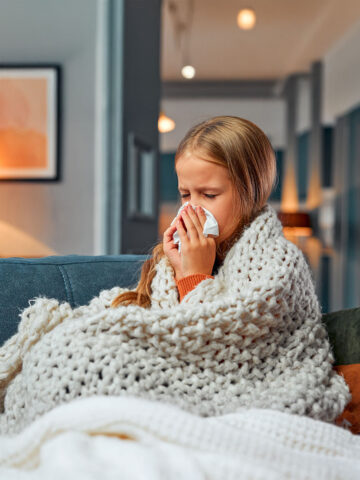How to protect against ticks – and what to do if you spot one on your child
Enjoy the great outdoors, but don’t forget about the threat of ticks. Ticks can carry diseases, including Lyme disease.
The good news is that, according to the Orange County Mosquito and Vector Control District, the county has not had a confirmed case of Lyme disease acquired from local ticks. The district also routinely tests for Lyme disease in local tick populations.
Just the same, it’s good to remain vigilant – especially when traveling to places with more risk. Here, Dr. Olga Guijon, a CHOC pediatrician, answers common questions about kids and ticks.
How can I protect against ticks?
Ticks don’t have to become a problem if you follow some basic tips.
Wardrobe and accessories matter
- Wear light-colored clothing to help you see ticks more easily.
- Wear closed shoes or boots, long-sleeve shirts, and pants.
- Tuck pant legs into socks or shoes for extra protection.
- Pull long hair back or wear a hat.
- Clothes also can be treated with a specific insecticide (like permethrin) to help prevent bites.
Choose locations wisely
- When hiking, stay on trails and avoid bushy areas with tall grass and leaf litter.
Take post-hike measures
- Wash kids’ skin with soap and water when they come back inside. If you’ve been in an area with ticks, wash all clothes in hot water and tumble dry on high heat before they’re worn again.
- Check your kids each day for ticks — look in and behind ears, in the groin area, behind the knees, in hair, in eyebrows and eyelashes, and under the arms.
- Also remember to inspect pets, clothing, and camping gear, including backpacks and sleeping bags.
- If you find a tick, remove it right away.
Are bug sprays with DEET safe for kids?
Insect repellents containing DEET have been tested and approved as safe for kids older than age 2 months. In addition to ticks, DEET helps protect against mosquitoes, biting flies, chiggers, and fleas.
However, while DEET is approved for babies 2 months and older, parents ought to apply sparingly in children under 2 years of age as their skin is different compared to older children.
But be sure to read all labels and take care when you use them:
- Choose a repellent with a 10% to 30% concentration of DEET (look for N,N-diethyl-m-toluamide on the label). The higher the concentration, the longer it lasts.
- Use lower concentrations (10%) if kids will be outside only for an hour or two.
- If they’re outside longer, consider using a repellent with up to 30% DEET, which lasts around five hours.
- Do not apply a repellent with DEET more than once a day.
DEET can be put on exposed skin, as well as clothing, socks and shoes. But don’t use it on your child’s face, under clothing, on cuts or irritated skin, or on the hands of young children. Here are some other tips for applying DEET:
- Do not use a single product containing both sunscreen and DEET. Sunscreen needs to be reapplied often, while DEET should not be used more than once a day.
- DEET concentrations higher than 30% are not more effective and the chemical (which is absorbed through the skin) in high amounts can be toxic. Follow the directions on the label.
- Do not apply repellent to kids’ hands because they could swallow it if they put their hands in their mouth. It also can irritate the eyes if they touch them.
- Don’t spray the repellent anywhere near the mouth.
- Apply the repellent in an open area so that you and your child don’t breathe it in.
- Wash kids’ skin with soap and water when they come back inside, and wash all clothes before they’re worn again.
Other bug repellents don’t contain DEET. The US Environmental Protection Agency has a list of approved repellents. Their tool can help you choose the right one for your family.
What to do if you find a tick on your child
First, don’t panic. It’s true that Lyme disease is the most common tick-borne disease in the United States. But your child’s risk of developing Lyme disease after being bitten by a tick is very low.
To be safe, though, you’ll want to remove the tick as soon as possible. The risk of infection rises 24 to 48 hours after the tick attaches to the skin.
Tick removal steps
- Step 1: Use tweezers to grasp the tick firmly at its head or mouth, next to the skin. Use a magnifying glass, if you have one, to see the tick clearly.
- Step 2: Pull firmly and steadily until the tick lets go of the skin. Do not twist the tick or rock it from side to side. Be careful not to compress the ticks body. If part of the tick stays in the skin, don’t worry. It will eventually come out on its own.
- Step 3: Release the tick into a jar or zip-locked bag.
- Step 4: Wash your hands and the site of the bite with soap and water.
Never use petroleum jelly or a hot match to kill and remove a tick. These methods don’t get the tick off the skin, and can make it burrow deeper and release more saliva, which makes it more likely to pass a disease.
What are the signs of tick-related diseases?
Most tick bites are harmless and don’t need medical treatment – especially in Orange County, CA. But some ticks (like the deer tick, wood tick and others) can carry harmful germs that cause diseases like Rocky Mountain spotted fever and Lyme disease.
Here are some things to look for:
- a red bump ringed by an expanding red rash, which looks like a bull’s-eye (Lyme disease);
- red dots on the ankles and wrists (Rocky Mountain spotted fever); or
- flu-like symptoms such as fever, headache, tiredness, vomiting and muscle and joint aches.
When should I call the doctor about tick bites?
Call your doctor if:
- Your child has had a tick bite, especially if the tick might have been on the skin for more than 24 hours. Sometimes, doctors prescribe a preventive dose of antibiotics for kids at high risk for Lyme disease.
- Part of the tick remains in the skin.
- A rash of any kind develops (especially a red-ringed bull’s-eye rash or red dots on wrists and ankles).
- The bite area looks infected (increasing warmth, swelling, pain, or oozing pus).
- Your child gets symptoms like a fever, headache, tiredness, stiff neck or back, joint swelling, or muscle or joint aches.
- Your child has facial paralysis (can’t move areas of the face).
What do doctors do if you have Lyme disease?
A pediatrician may be able to diagnose Lyme disease based on a child’s bull’s-eye rash, or they might order a blood test.
If Lyme disease is confirmed, the doctor will prescribe an antibiotic, a medicine that kills the spirochetes, the bacteria carried by some ticks.





